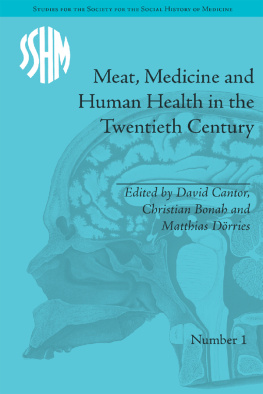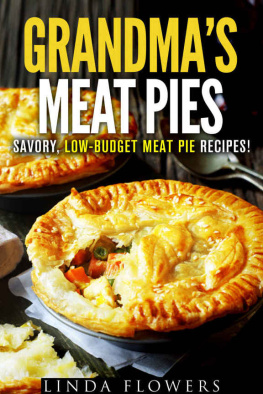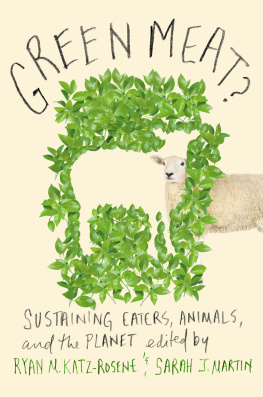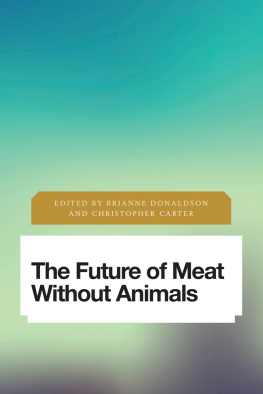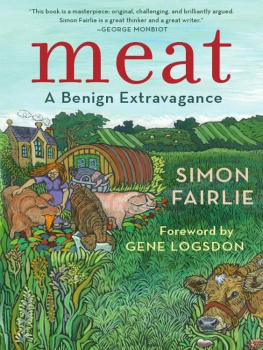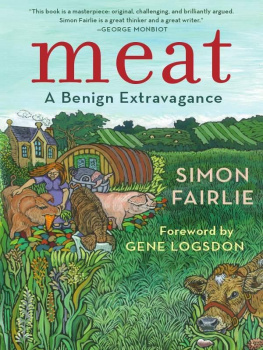University of Iowa Press, Iowa City 52242
Copyright 2018 by the University of Iowa Press
www.uipress.uiowa.edu
Printed in the United States of America
Design by Shaun Allshouse
No part of this book may be reproduced or used in any form or by any means without permission in writing from the publisher. All reasonable steps have been taken to contact copyright holders of material used in this book. The publisher would be pleased to make suitable arrangements with any whom it has not been possible to reach.
The University of Iowa Press is a member of Green Press Initiative and is committed to preserving natural resources.
Printed on acid-free paper
Cataloging-in-Publication data for Meat Makes People Powerful by Wilson J. Warren is on file at the Library of Congress.
ISBN 978-1-60938-555-2 (pbk)
ISBN 978-1-60938-556-9 (ebk)
Preface and Acknowledgments
I started this project in 2008 when I was a Fulbright lecturer in American Studies at Doshisha University in Kyoto, Japan. Although I am a modern US historian by training, I have a long-standing interest in Japan. My first experience there was as an English teacher for the Japan Exchange and Teaching (JET) program in Miyazaki in 1991 and 1992. While teaching on Doshishas Kyoto campus, located adjacent to the imperial palace grounds, I discovered the Go Shrine, also located next to the imperial grounds about a mile from the campus. Go is a small Shinto shrine with an entrance guarded by wild boars instead of the usual stone-carved mythical lions, or komainu. The shrine commemorates Lord Wake no Kiyomaro, who lived in the eighth century. Wake no Kiyomaro was banished to Japans far south because he opposed an attempt by female emperor Kken (r. 749758)who had returned to the throne as Shtoku (r. 764770)to place the Buddhist cleric Dky on the throne after her. Not only was Wake no Kiyomaro banished, but his leg tendons were severed to hobble him. According to folklore, as Wake no Kiyomaros carriage traveled in the Kagoshima countryside, he was suddenly surrounded by three hundred wild boars. Instead of attacking him, they escorted him to safety. In the process, his leg injuries were healed. The shrine is therefore popular among those with leg injuries.
Although Lord Wake no Kiyomaro is revered as a deity in the Go Shrine, the grounds include an amazing array of displays featuring wild boars. Boars have powerful totem meaning in many cultures, including East Asia, and they are also one of the few wild animals that still roam parts of Japan. The Go Shrine includes statues, paintings, and other depictions of boars, including stuffed ones. My daughter and I bought boar good luck charms, but not because of concerns about leg injuries. Although the story of Lord Wake no Kiyomara has nothing to do with eating wild boar, the shrine is thought-provoking about the role of human-animal relations in Japans history. Because I was working on Japans meat history, each time I visited there I thought about its peoples long history of avoiding many types of animal foods and then how rapidly Japanese people had incorporated meat into their diets in the modern era. As part of a longer parody on Japans rapid Westernization, Kanagaki Robun, one of the countrys Meiji era meat skeptics, suggested that beef eating makes people powerful. Borrowing from Kanagaki, I find that Meat Makes People Powerful is useful as a book title because it suggests the various reasons why people have incorporated and desired animal products. I hope this book sheds some light on the multiple dimensions and effects that accompanied meats history in Japan as well as other nations around the globe. Please note that this text follows Japanese custom and scholarly convention by noting Japanese names with surname first and given name last.
I have been working on projects related to meat history for over three decades and have been helped by many people during that time. For this project, I would like to acknowledge the Japanese translation assistance I received from several Doshisha University American studies graduate students: Hara Emiko, Izumi Masashi, Komatsu Tobihiko, and Nishijima Yumi. My American studies colleagues at Doshisha University graciously allowed me to present some of my early research on Japans meat history. I am especially grateful to Professors Gavin Campbell and Ikeda Keiko for their collegiality and support. After I began to draft parts of this book, Professor Donald Stull kindly read and commented on sections focused on Japans meat history. In 2010, I was fortunate to be able to present the Richard Geiger History Lecture at St. Ambrose University in their series The Ubiquity of Work. In that lecture, I discussed an early version of on the state and meat. I am honored that the lecture committee members, Professors Ryan Dye, Daniel La Corte, Keri Manning, Sandy McKinley, and Larry Skillin, chose me for this opportunity, especially since I had a chance to see and visit with my undergraduate professor and longtime friend, Richard Geiger. Sadly, Richard has since passed away, but his interest in my work always meant a great deal to me.
My colleagues in the department of history at Western Michigan University have also provided me with help and support. I would especially like to acknowledge Professors Buddy Gray and Yoshida Takashi for their interest in discussing aspects of German and Japanese history as they relate to meat and food issues. Western Michigan Universitys Office of the Provost awarded me much-appreciated sabbatical support in the academic year 20082009 and in the fall semester of 2015. I am also grateful for additional financial support from WMUs Faculty Research and Creative Activities Award in the 20082009 academic year. WMUs Resource Sharing Center unfailingly filled every one of my dozens of requests for all manner of books related to meat. As with my previous book on meat and the Midwest, I could have not completed this project without the help and support of the fine staff in the Resource Sharing Center.
At the University of Iowa Press, four anonymous reviewers provided incisive comments that helped me to refine my narratives focus. I am indebted to Catherine Cocks, the presss editorial director during the period that I worked on this manuscript, for her guidance and support. Susan Hill Newton then oversaw the project from manuscript to book. I am also grateful to Rebecca Marsh for her careful copyediting and thoughtful suggestions for improvements.
I am fortunate to have good friends who have listened to me talk at length about this project. Thanks especially to Gordon Andrews, James Cousins, Cheryl Lyon-Jenness, and Curt Miner. I also thank Nancy Spicketts for her love and support.
My three children, John, James, and Katherine, have been my greatest source of pride and joy. We shared many adventures together in Japan in 2008 and 2009. All three grew from adolescence to adulthood during the years I worked on this book, and each knows the many highs and lows that we faced as a family during that time. John has been a vegan for several years now, and he and I have had many discussions about issues related to meat and veganism that have helped me think about several parts of this book. I am proud of his ethical commitments and grateful to all my children for their love and support. I dedicate this book to them.


